P.64 ausbiz. news
p.66 the benefits of bonds
P.72 meet an aussie farmer
P.76 embracing ai in schools
p.80 mining’s dust problem
P.84 crunch time for potatoes
p.88 three awesome charities
92. BUZZ OFF
We speak to three Australian farmers on the frontline of the war against fruit flies: one of the world’s most destructive agricultural pests.
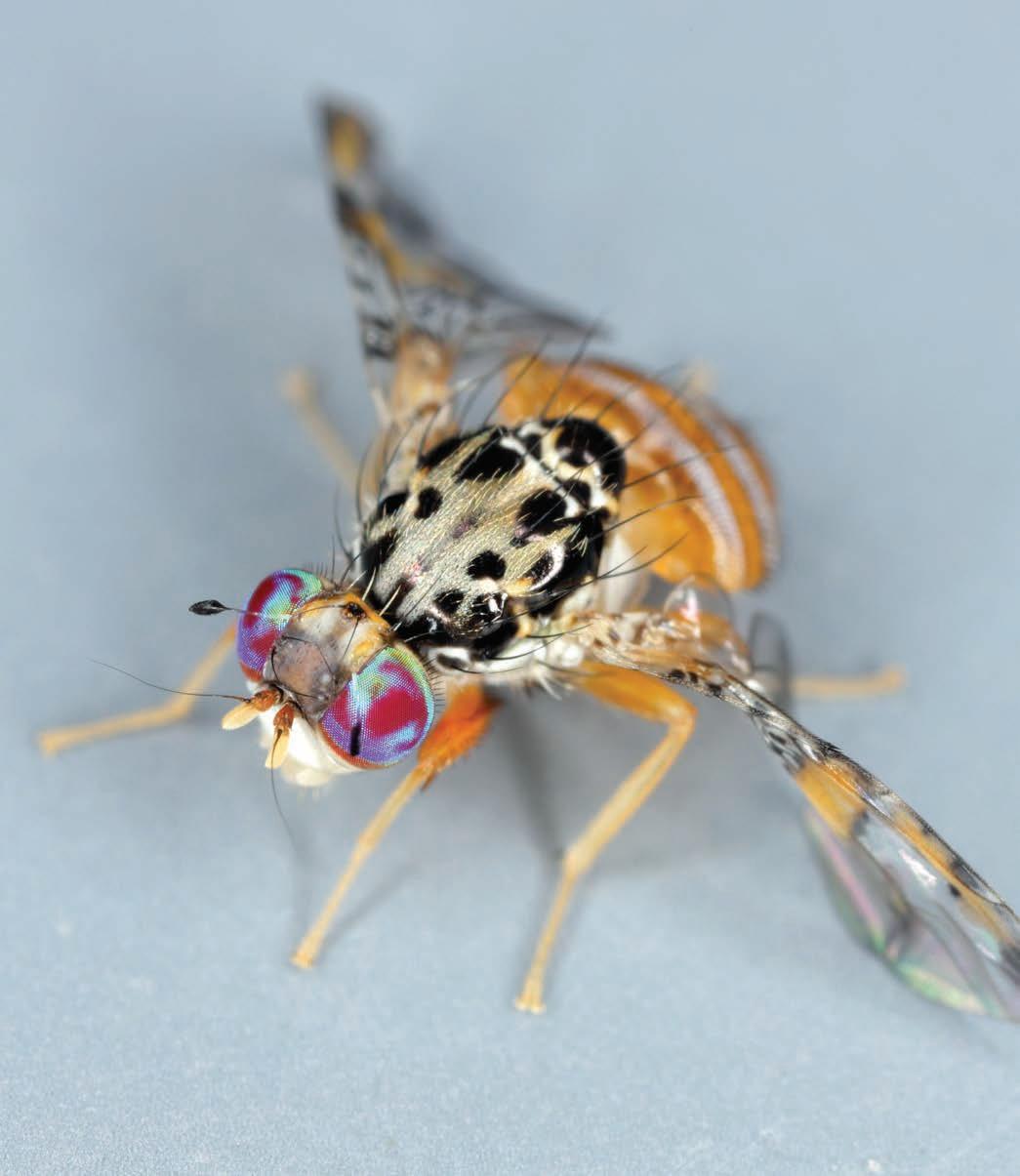
NEWS | Finance | mining | agriculture | charity | environment
THE FUTURE OF RICE PRODUCTION

Australia’s rice industry is attempting to increase water efficiency by 75 per cent over the next five years. Rice Breeding Australia (RBA), an organisation established in 2022, is on a mission to research types of rice that require less water in production, leading to a more environmentally friendly crop. But the road ahead isn’t smooth.
For the past five years, production of rice was equivalent to 0.8 tonnes per megalitre of water. Ninety-eight per cent of this was produced in the Riverina region of New South Wales. According to Georgina Pengilley, CEO of RBA, the main focus of the research is on genetics, in the hopes of finding breed varieties that require less water.
“We look to take those best ones forward for the growers to have, and start to meet those water productivity targets,” she says.
There are many variables to consider when growing rice, such as the availability of water, weather and variety in yield. These factors mean a water efficiency target is a very difficult goal, one which requires more than just a lessthirsty crop. Rice is also impacted by cold temperatures, so farmers create a blanket of water to keep the crop insulated for the majority of the growing period. This means that
A meteoric Valentine’s day NASA is tracking an asteroid that could collide with Earth around Valentine’s Day in 2046. Measuring approximately 50 meters wide – the length of an Olympic swimming pool – this floating object has been named 2023 DW, and has an estimated one in 607 chance of hitting our small blue planet.

As with all unusual sightings, 2023 DW has been added to the ‘risk list,’ a compilation of objects in space that have the potential to affect Earth. Each object is ranked on the Torino scale, which was developed in 1999 and rates an object’s potential to collide with Earth. The newly discovered asteroid was ranked at level one on the scale, meaning it “poses no unusual level of danger,” and “the chance of collision is unlikely, with no cause for public concern.” However, 2023 DW is the only asteroid on a list of 1,448 others that ranks higher than zero on the Torino Scale.
Italian astronomer Piero Sicoli added to the conversation by predicting that the chance of 2023 DW hitting Earth was actually one in 400, and even created a map of possible locations where the asteroid could land. However, he believes the possibility of impact will soon be ruled out. With over two decades before any real threat emerges, NASA officials remain confident that 2023 DW poses no significant threat to our planet.
researchers are also tasked with finding a crop with a higher temperature tolerance to negate this need for extra water. Despite these challenges, Georgina remains optimistic about the future of the industry.
“Genetics is a long game, so for RBA the main key is that we can demonstrate we’re making inroads,” she says. “The more numbers we have in the program, the more opportunity we’ve got to look at germ plasm and therefore end up with a variety that’s going to work for the growers.”
64 AusBiz. AUSBIZ NEWS
Cheriton Valley: A PICTURESQUE HAVEN AND THE PERFECT CITY ESCAPE
Nestled in the beautiful Cheriton Valley just minutes north of the town of Gingin, an exclusive country address with an idyllic lifestyle in a safe, close-knit community awaits. It offers the best of countryside living while being on the fringes of Perth.


Country Heights Estate has been developed to an exceptional standard with fast-speed internet, scheme water, power and sealed roads, whilst retaining its rural charm and natural beauty – with stands of mature gum trees and untouched bush adding to its appeal.
The stunning estate is home to 313 exclusive 1-hectare lots, plus rural residential homesites with utterly breathtaking views of rolling hills and sweeping valleys.
Claymont Chairman Jerry Goh says fully serviced large hectarage home sites having scheme water in such close proximity to metro areas are a rarity, with the homesites being 25 times larger than the average suburban home site, for a better price.

The enchanting estate aims to deliver an improved quality of life with plenty of fresh air and wide-open country spaces for the whole family to enjoy, while also offering enough space for large pets to roam and play.
ACCESSIBLE, AFFORDABLE, WITH THE BEST OF BOTH WORLDS
Country Heights Estate is easily accessible via the completed NorthLink Tonkin Highway extension. With this new development, travel times to myriad metro areas with high-density work places and shopping centres have been significantly slashed.
Joondalup, Wangara, Malaga, Morley, Balcatta, Ellenbrook and Midlands are between 30 minutes to 45 minutes from the estate, and the airport and Perth CBD are an hour or less away.
“With its excellent accessibility, Country Heights Estate offers a unique opportunity to live the ultimate lifestyle with the best of both worlds – healthy living in a safe country community on large hectarage home sites, and the ability to work in metro areas with an easy commute,” says Jerry.

As a result of the lockdown experienced during the pandemic, there is a growing popularity with city-dwellers seeking a lifestyle change to regional areas which are within easy commutable distance to the city. It gives them more room and space to spend quality time at home, with more flexible work-fromhome lifestyles.
“The availability of high-speed internet here is perfect for those who desire a rural work-from-home lifestyle, making Country Heights Estate an ideal place to live and work partly or fully from home,” Jerry says.
The nearby Gingin town has every a tree-changer could possibly want – including great schools, a medical centre, post office, bank, hotel, cafes, shops, and numerous recreational and sporting facilities.
Ideal for the building of a family home, retirement, an investment, or to claim your own weekender on the edge of the Darling Scarp, the estate is also within easy reach of coastal communities such as Lancelin, Seabird and Guilderton on the pristine Moore River.
WHAT’S ON OFFER
Stage 1 included 45 homesites that were well received, as it is now sold out. The next 61 homesites will be released in Stage 2 comprising Stage 2A, 2B and 2C with titles expected early in 2023. Selling prices start from $215,000 to $305,000 for premium elevated homesites with stunning panoramic valley views.
Take a scenic drive to Country Heights Estate to see it for yourself.
For more information, please visit countryheightsestate.com.au (or use the QR code below).

Alternatively, contact our agents Tom Cabassi: 0429 095 864 or Rob French: 0401 970 997.

APRIL/MAY 2023 65
PROPERTY
FEATURE
IS IT TIME TO CONSIDER BONDS IN YOUR INVESTMENT PORTFOLIO?
Saxo Australia’s CEO Adam Smith talks us through the role of bonds in your investment portfolio, as well as some of the risks and benefits.


words: Adam Smith
As global share markets remain hostage to inflation, increasing interest rates and other economic data, it could be time to look further afield for other investment opportunities that may generate returns. One asset class that is very popular overseas and is starting to gain traction here in Australia is fixed income. Bonds are the most common form of fixed-income securities.
A bond is a so-called debt instrument that pays a fixed amount of interest, usually at regular intervals typically distributed annually or semi-annually. The initial investment amount (also known as the principal) is paid back to the investor when the bond expires (known as maturity).
So, a bond is actually a loan that
the bond purchaser, or bondholder, makes to the bond issuer.
Governments and corporations (including banks or companies such as Apple and Microsoft) will issue bonds when they want to raise capital for a variety of reasons. An investor who buys a government bond is basically lending the government
money. If an investor buys a corporate bond, the investor is lending the corporation money. So, if you buy a bond from a bank you are actually lending to them – not the other way around for once!
Like any investment, investing in bonds is not without risk. Every bond carries some risk that the issuer will “default,” or fail to fully repay the loan (or principal). It is the job of independent credit rating services (Moody’s, S&P etc.) to assess the default risk, or credit risk, of bond issuers and publish credit ratings that not only help investors evaluate risk, but also help determine the interest rates on individual bonds.
Generally, investors should be paid more in interest if they take a greater
THIS PAGE:
ADAM SMITH (BELOW) EXPLAINS HOW BONDS CAN WORK FOR YOUR LIFESTYLE.
READ IT ONLINE 66 AusBiz. FINANCE
risk of not getting their initial investment back and vice versa. An issuer with a high credit rating will pay a lower interest rate (as its cashflows have a higher certainty of being paid, so it is a relatively less risky investment) than one with a low credit rating. Again, investors who purchase bonds with low credit ratings can potentially earn higher returns, but they must bear the additional risk of default by the bond issuer.
THE ROLE OF BONDS IN A PORTFOLIO
Experienced investors appreciate the need for diversification in their investment portfolios. An allocation of some part of your portfolio into
bonds can help you achieve this. Investors purchase bonds for a number of reasons: capital preservation, income, diversification and as a potential hedge against economic weakness or deflation.
Capital preservation: Unlike equities, bonds should repay principal at a specified date, or maturity. This makes bonds appealing to investors who want a small risk of losing capital. Bonds have the added benefit of offering interest at a set rate that is often higher than short-term savings rates.
Income: Most bonds provide the investor with 'fixed' income. On a set schedule, whether quarterly, semiannually or annually, the bond issuer sends the bondholder an interest payment, which can be spent or reinvested in other bonds. Stocks can also provide income through dividend payments, but dividends tend to be smaller than bond coupon payments, and companies make dividend payments at their discretion, while bond issuers are obligated to make coupon payments.
Capital appreciation: Bond prices can rise for several reasons, including a drop in interest rates and an improvement in the credit standing of the issuer.
Diversification: Including bonds in an investment portfolio can help diversify the portfolio. Many investors diversify among a wide variety of assets, from equities and bonds to commodities and alternative investments, to reduce the risk of low, or even negative, returns.
Potential hedge against an economic slowdown or deflation: Bonds can help protect investors against an economic slowdown for several reasons. The price of a bond depends on how much investors value the income the bond provides. Most bonds pay a fixed income that doesn’t change i.e. an investment in a bond provides an element of cashflow certainty for an investor.
HOW MUCH OF MY PORTFOLIO SHOULD I ALLOCATE TO BONDS?
The honest answer is there is no one-size-fits-all answer to the question of how much of a portfolio investors should allocate to bonds, as the appropriate allocation will depend on a number of factors, including the investor’s goals, risk tolerance, time horizon and current market conditions.

That said, a widely circulated rule of thumb among financial advisors for determining an appropriate allocation to bonds is based on the investor's age. With the assumption that bonds offer lower, but less volatile returns than stocks over time, the rule of thumb suggests that investors should subtract their age from 100, and allocate that percentage of their portfolio to stocks, with the remainder allocated to bonds.
For example, a 30-year-old investor would allocate approximately 70 per cent of their portfolio to stocks (100 minus 30), and 30 per cent to bonds. As the investor gets older and approaches retirement, the allocation to bonds would gradually increase, as a way to reduce overall portfolio risk and volatility.
It’s important to note that this rule of thumb is just one approach to determining an appropriate allocation to bonds and may not be suitable for all investors.
APRIL/MAY 2023 67 FINANCE
“Investors who purchase bonds with low credit ratings can potentially earn higher returns, but they must bear the additional risk of default by the bond issuer.”
MEET HIDDUP
generate returns as there are always transactions that need verification.
“In its simplest form, we’re a middleman that helps process blockchain transactions.”
With record increases in interest rates and the cost-of-living surging in almost every sector, consumer confidence has plummeted heading in early 2023. With the pessimistic outlook for market performance growing across many industries, many Australians are reassessing their strategies to generate and grow wealth.
“We’ve really seen a major shift in the mindset of many Australians over the past year or so," says Adam. "They’re worried about losing purchasing power, their property values have significantly decreased and they’re really concerned about their retirement. Fortunately, we have strategies and solutions that can cater to almost anyone.”
Australians have recently endured some of the toughest financial conditions we’ve ever seen.
With rampant inflation eroding the purchasing power of households, teamed with skyrocketing interest rates, more and more families are feeling the pinch.
With 2022 being one of the most turbulent years for investors since the Global Financial Crisis, now morethan ever, many Australians feel they’re falling behind financially.
However, amidst this global economic uncertainty, one Gold Coast-based company is providing
an alternative solution to growing wealth, thanks to its unique market offering.
The company attributes its innovation to blockchain mining – the underlying method used to generate fixed-rate returns, which range from 6 to 16 per cent per annum.
“Most people haven’t heard about blockchain mining, but in layman’s terms, we derive revenue based on people trading assets around the world," says Founder Adam Lane.
“Whether the market is going up, down, or sideways, it doesn’t neccessarily impact our ability to
Hiddup’s subscriptions operate on varying life cycles of two, three, five, seven, and ten years, with returns varying based on subscription term and initial amount. Returns are generated passively and are paid out on a daily basis. With no management or subscription feeds, it’s easy to see why this model is grabbing the attention of many Australians.
The company underpins consumer confidence by returning members' initial subscription amount in full, at the end of their term. It’s clear that this alternative wealth creation solution is captivating the attention of many Australians as they look to create a new passive income stream.
Whether you’re looking for a way to diversify income, save for retirement, or hedge against rising economic uncertainty, Hiddup is pioneering an innovative way for Australians to reach their goals. For more information, please visit hiddup.com

68 AusBiz. FINANCE
The Australian company offering members relief amidst the rising cost of living.
“Whether the market is going up, down or sideways, it doesn’t really impact our ability to generate returns as there are always transactions that need verification.”




backed by Australia-wide support
Designed specifically for mine sites and stockpile management, Carlson stockpile machine guidance solutions deliver meaningful safety and productivity benefits.


Backed by Position Partners’ network of on-site and online technical expertise, we offer comprehensive support and deployment Australia-wide

Get in touch today: info@positionpartners.com.au www.positionpartners.com.au Australia • New Zealand • SE Asia 1300 867 266 STOCKPILE UP PRODUCTIVITY Reduce coal contamination by monitoring stockpile floor level RELAY & REPORT Analyse machine replay to gain operational insights for your site Scan me to learn more INCREASE SAFETY Proximity warnings for infrastructure, machines, coal floor & more MACHINE GUIDANCE
Machine Guidance
Stockpile
Position Partners opens new Melbourne office
Position Partners has relocated its office in Melbourne’s northwest from Campbellfield to 42 Enterprise Drive, Bundoora. The new branch offers a service centre, showroom and a national warehouse that support customers in the civil construction, building, geospatial and mining sectors.

The company’s former premises at 7 Transit Drive, Campbellfield were destroyed by a widespread fire on Christmas Day 2022, caused by an electrical fault.
“We appreciate the support of our customers, suppliers and partners as
we have worked through the impact of the unfortunate fire at our Campbellfield branch,” said Martin Nix, Position Partners CEO.
“Thanks to the extraordinary efforts of our people and partners such as Topcon we have returned to normal operational business and are now able to welcome customers to our re-established national premises.”
The branch at 42 Enterprise Drive, Bundoora offers sales, rental, training and workshop services for laser levels, machine systems and geospatial positioning instruments in the northwest of Melbourne.
Additionally, Position Partners continues to support customers in Melbourne’s southeast with its office in Dandenong South.
As one of the company’s national warehouses, the new Bundoora branch supports more than 300 hardware stores nationally with the supply of Topcon and iMEX laser level tools. It has a large service centre with capacity to repair and calibrate laser levels, optical total stations, GNSS instruments and more. It is also the operational centre for AllDayRTK, the Australia and New Zealand GNSS network infrastructure that supports high precision GNSS applications.
The company has branches in all other major cities in every state and territory of Australia, as well as Auckland, New Zealand, Singapore and Jakarta, Indonesia.
For more information about Position Partners and the company's wide range of solutions, visit positionpartners.com.au.

APRIL/MAY 2023 71 POSITION PARTNERS
The company relocates its northwest Melbourne office to Bundoora and continues to operate a second branch in Dandenong to service customers in the city’s southeast.
MEET A FARMER: CATHERINE VELISHA
Catherine and the team at Velisha Farms are hoping to change the conversation around ‘perfection.’ Alongside Farmer’s Pick, they’re championing a more realistic approach to horticulture, emphasising taste over appearance. We chatted to her about family, business and how the industry has changed over time.
Words: Matilda Meikle
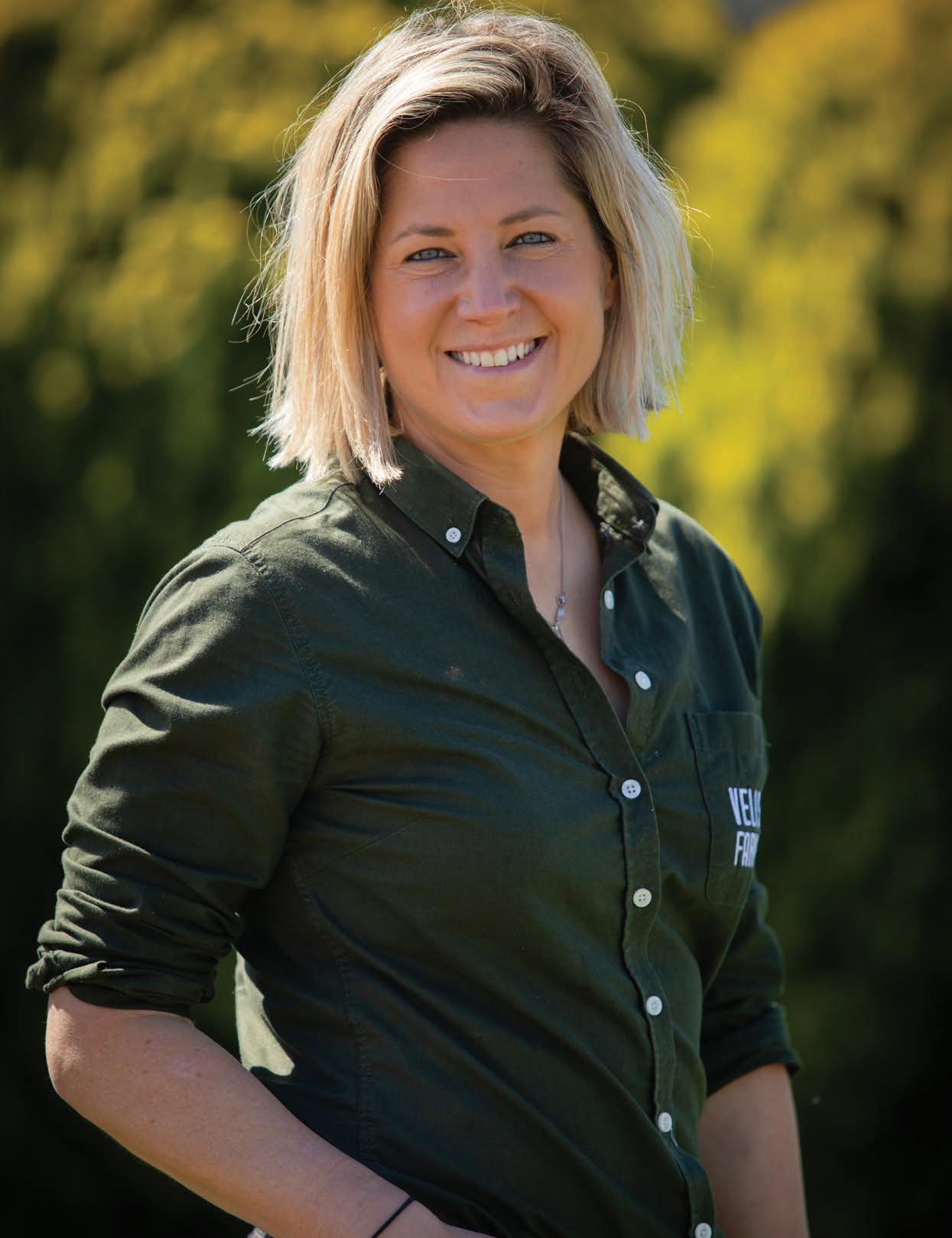
72 AusBiz.
READ IT ONLINE
Are you a first-generation farmer, or has it run in the family? When did you first start your farm business?
Velisha Farms is a third-generation horticulture business. My grandfather came from Albania with his two brothers in the 1930s, and they started a dairy farm. When World War II broke out, the nearby army base needed vegetables for the soldiers, so they changed to horticultural production. Then my dad and the other kids were born. I joined the farm when I was 19, and I’ve been working in the farming business now for 20 years. I even purchased the business from my father five years ago, so now I’m the sole owner.
How many acres of land is your farm? What do you grow?
We own 150 acres ourselves, but we have about 2,000 to 3,000 acres of other growers working for us as well. We help the other farmers with the quality aspects of the sales, as well as logistics and planning, and they supply us with some fantastic produce. Our main lines are cauliflower, broccoli, celery, kale, spring onions, zucchini and cucumbers.
Is innovation a big part of running a farm business? How have you innovated since you first started? Innovation is a huge part of horticulture. The industry is getting more and more competitive, so we always need to be improving efficiency. The biggest change is probably focusing on people, and the skills we want to bring in. We’re working on how to upskill and attract new talent, so we can push
boundaries further and further. Farmers are the original entrepreneurs, and we want to share that with a new generation.
What have been the biggest challenges you’ve faced as a farmer?
The weather is a constant challenge, but also increasing costs. There's still resistance from customers to spend more on fresh produce. And that’s coupled with challenges in food waste. Customers don’t want ‘imperfect’ produce, but food safety and food appearance are very different things. They've been grouped together, but you can have really safe food even when the appearance isn’t up to standard. That’s a conversation that needs to change.
What have been some of the biggest changes you’ve seen in farming over the past ten years?
Ten years ago, the appearance of fresh produce wasn't as important, it wasn't used by retailers to gain value. Because we've become accustomed to things looking a certain way, pressure has built over the last few years. When you go into a supermarket, all the oranges are completely identical, the broccoli is all the same size. But things don’t grow like that. Luckily, the conversation is definitely changing thanks to groups like Farmer’s Pick. It’s not nearly big enough yet, but awareness is growing.
How did you get involved with Farmers Pick? Why is fighting food waste important to you?
Farmer’s Pick reached out to us to supply them with stock, and it meant
valuable sales for our entire harvest. But on a personal level, I think they open the door to a really important conversation about what perfection is, and the cost of that along the supply chain – to customers, to growers and to the planet.
Most people don’t know, but produce that doesn’t look as perfect actually has more flavour. When things look perfect, they’re often immaturely picked, or they haven’t had the time to develop properly. So, we’re compromising taste for physical appearance.
What is one of your most satisfying or proudest moments?
I think developing as a farmer. I started surrounded by my peers, and now they’re under my charge, so being able to grow with them has been very exciting. But also seeing how companies are challenging the status quo, so we can start asking the right questions and giving people amazing produce no matter how it looks.
What is next for you and your business?
Our business is constantly evolving. We’re particularly focused on sustainability, and we’ve also developed an educational business that branches off the horticulture business. Knowledge is power, and people don't know a lot about our industry. We want to take the power back and start teaching people what it takes to be a farmer, what it takes to grow our produce: the risks, the challenges, all of what’s involved. So, when you go into a store, you're valuing the product more and you understand that little blemishes or imperfections are just normal, and the quality of the produce is still high. The education program is running alongside our farming business, to hopefully help our business and the industry as a whole.
APRIL/MAY 2023 73 AUSSIE FARMERS
“We’re working on how to upskill and attract new talent, so we can push boundaries further and further.”
POWER FARMING’S HANDLER OF THE YEAR 2023
As one of the most popular models in Merlo’s extensive Turbofarmer range, the TF42.7 has been named Handler of the Year 2023 by Power Farming, a leading agri-tech magazine.
Merlo has been pioneering the combination of a side-mounted engine and hydrostatic transmission since the 1980s, with their farm handler, the Turbofarmer, being introduced in 1996. The Turbofarmer remains at the core of Merlo’s agricultural telehandler product range.
The Turbofarmer’s low profile, distinctive ‘ring of steel’ reinforcing and 74 AusBiz.
hydrostatic drive have helped make Merlo leaders in performance, precision, safety, comfort and efficiency.
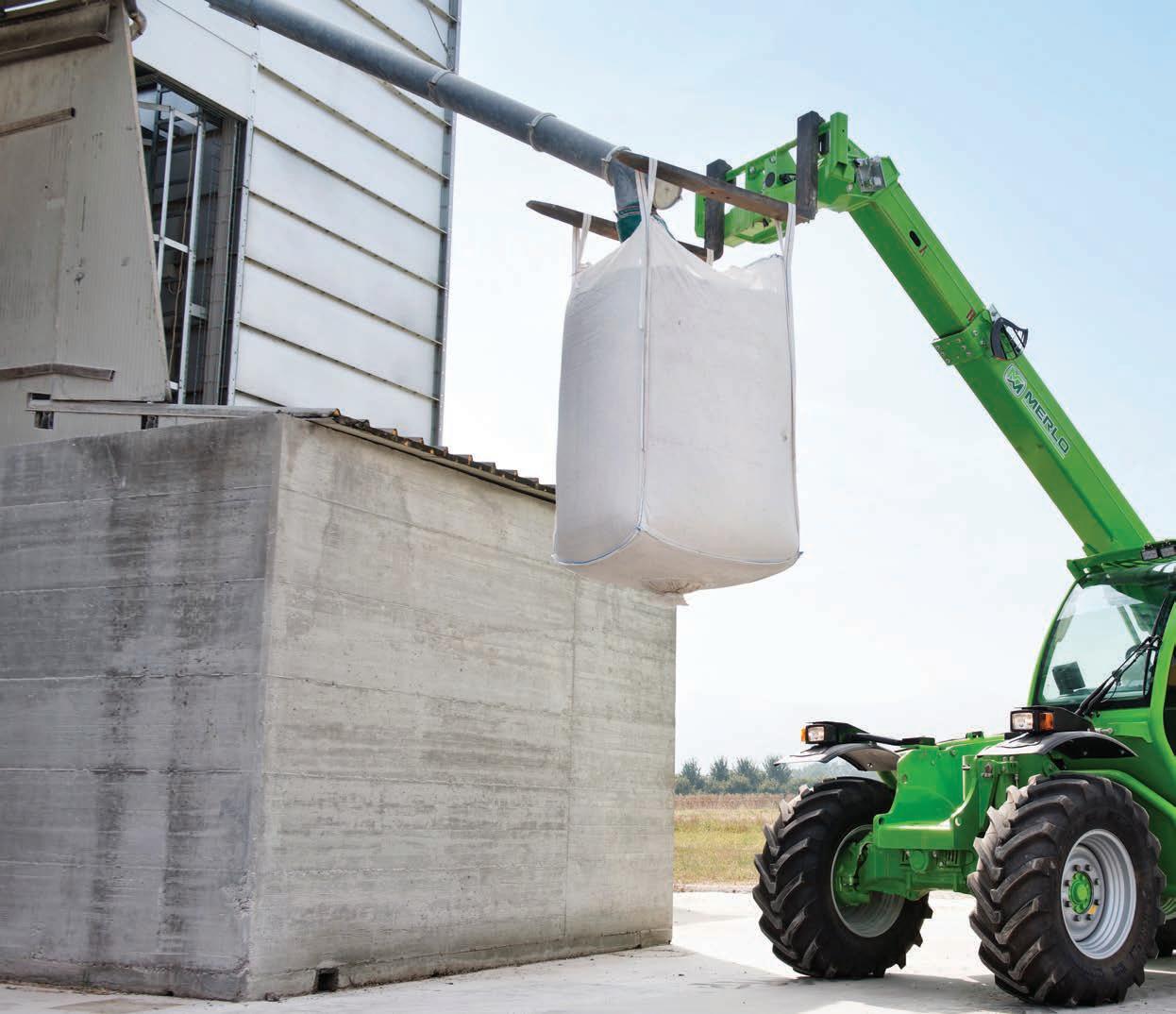
Merlo has an extensive agricultural dealer network across Europe and the world. Like all Merlo telescopic handlers, the Turbofarmer 42.7 is built in the company’s Defendente di Cervasca factory near Cuneo in the south-west corner of northern Italy.
TURBOFARMER 42.7
One of the key models in the Merlo agricultural telescopic handler range, the Turbofarmer 42.7 meets growing demand for more productive mid-range models with greater lift capacity of 4.2 tonnes, combined with a 7-metre lift height. These handlers suit large livestock enterprises – both beef and dairy – as well as cropping properties.
With a width over the standard tyres of 2,310mm and a height to the cab roof of 2,530mm, the machine has a strong presence without being overly
bulky. It is available in base form or with a handful of specialist optional equipment which can be tailor-made to suit each customer.
These ‘value-added’ versions include a suspension mounted cab for added comfort over long working hours; chassis levelling for working at height on an uneven or sloping surface; boom side-shift for precision placement of loads; and a CVT ground drive system without intermediate gears.
For more, visit merlo.com/AUS/eng

ENGINE SPECS
Merlo has opted to fit the TF42.7 with a 3.6-litre, four-cylinder Deutz engine, which develops 100kW (136hp) and puts it near the top of the table in terms of power output.


The Turbofarmer engine has easy access to service points and other components for routine servicing and for access in-paddock, if needed. The engine bay is a busy place, however, accommodating a large cooling pack for engine, transmission and hydraulic oil temperature control, and exhaust emissions after-treatment hardware.
Since the cooling fan is driven by a hydraulic motor, its speed is moderated according to the degree of cooling needed at any time, and can be reversed to clear dust and debris from the radiator and coolers.
CAB FEATURES
The suspended cab is the jewel in Merlo’s crown, delivering a plush and enviably smooth ride across even the roughest paddocks, greatly adding to operator comfort levels and extending work periods.

The operator position places everything within easy reach and sight, including the colour display monitor for the ASCS safe working system and reversing camera feed.
In the cab, the stability display changes in real time to help the operator keep the boom within a safe operating envelope for the load carried. Safe movements when limits have been reached are highlighted and there is also an inclinometer. A supportive joystick goes ‘live’ when it detects the presence of the operator’s hand.
“The Turbofarmer’s low profile, distinctive ‘ring of steel’ reinforcing and hydrostatic drive have helped make Merlo leaders in performance, precision, safety, comfort and efficiency.”
LEFT: THE MERLO TURBOFARMER 42.7 HAS A 4.2 TONNE LIFT CAPACITY AND 7-METRE LIFT HEIGHT FOR A VARIETY OF ON-FARM USES.
DECEMBER/JANUARY 2023 75 AGRITECH
AI IN SCHOOLS
With the rise of Artificial Intelligence (AI) software, it’s time to consider the impact it's having on global education.

Words: Matilda Meikle
THIS PAGE: THE AI SOFTWARE CHATGPT HAS CHANGED THE PLAYING FIELD FOR EDUCATION. SO, HOW CAN SCHOOLS USE AI TO THEIR OWN BENEFIT?
76 AusBiz.
EDUCATION READ IT ONLINE
Around the world, AI is becoming more prominent and accessible. With the click of a button, students can connect to ChatGPT, an AI software which can complete almost any task from a few simple commands –including writing essays and university assignments.

While the results usually aren’t of a standard high enough to reach the top marks, the material is often difficult to distinguish from a student's actual work. This means students can now submit assignments using minimal effort and time, leading to major academic concerns.
Other issues about bringing AI into the educational sphere include the possibility of widening the technological divide between countries, giving some even greater access to knowledge than others.
More and more, people are coming to realise the possibilities and limitations of using AI in the classroom. But while it has several negative implications that could disrupt the educational system, there are also some advantages. So, how can AI help to enhance student learning? And how can we ensure it is equal for everyone?
THE DIGITAL DILEMMA
ChatGPT has left many wondering if there’s a future for productive technologically enhanced learning. Two researchers are leading the charge towards this more positive outlook on AI.
Dr Armin Alimardani, from University of Wollongong’s School of Law, studies the legal, social and ethical impacts of technology. Over the past year, he has worked with University of NSW Associate Professor Emma A. Jane to develop an AI program which supports student learning by providing instant feedback and facilitating conversations about the course.
This work has resulted in the Safe-tofail AI website, which can be used as a tool for university teaching. Unlike similar programs, Armin and Emma have ensured the tool is free and accessible for all.
“One of the key motivations behind the project is the need to democratise the development and use of emerging technologies like AI,” Armin says.
“We believe it's important for nonexperts to have a greater understanding of what AI can and can’t do, and to

APRIL/MAY 2023 77
EDUCATION
“We wanted to create a platform that is accessible to everyone and that doesn't require any knowledge of coding.”
have more control over how it is used and developed, rather than leaving it to commercial companies to shape the future of AI in education.
“Many big technology companies offer easy-to-use AI platforms, but these often come at a significant cost, such as large upfront payments or opaque data harvesting. We wanted to create a platform that is accessible to everyone and that doesn't require any knowledge of coding. Our goal is to ensure that our universities, at least, don’t have to rely on such costly and potentially problematic solutions.”
PROGRAMMING FOR PEOPLE
Safe-to-fail includes many programs aimed at supporting students while they tackle their university courses. SmartTest is one such program, allowing educators to examine student’s understanding of the course material and provide instant feedback to their answers for openended questions.

SmartTest uses work provided by the teacher to assess student answers in realtime, offering feedback and suggesting areas of improvement. The aim is to encourage deeper engagement with the course content and nurture critical thinking.
Another tool on the system is FAQ 2.0, which allows educators to upload their course outlines and any important information related to the degree. Students can then find answers to any questions they may have without having to sort through pages and pages of notes or send repetitive emails to their teachers. If that wasn’t enough, (A)icon allows users to ask questions and start conversations with educators, receiving answers through a casual and personalised dialogue.
“While there has been much discussion surrounding the potential misuse of ChatGPT by students, our project is a prime example of looking at the flip side of AI – that is, how it can assist educators to save time and improve the quality of learning for students,” says Armin.
“Our aim is to offer an interactive and engaging experience for students. It’s not intended to replace human
interaction, but rather act as an additional support in students’ learning and development process.”
While the project is well on its way to becoming an invaluable teaching tool, it's still in its early stages. Prototyping has just been completed, and the lead researchers are now testing whether the AI meets the values of the project – inclusivity, transparency and accountability – as well as making a meaningful impact on the learning environment. Throughout 2023, they will continue tweaking the tool and seeking feedback, with the hopes of launching the site soon.
There’s so many questions surrounding the future of learning, and how AI will play a role. But with projects like Safe-tofail placing meaningful education at the forefront of their values, there’s still hope that AI will only enhance learning for people around the world.
78 AusBiz.
“Our aim is to offer an interactive and engaging experience for students. It’s not intended to replace human interaction, but rather act as an additional support in students’ learning and development process.”
EDUCATION
THIS
PAGE: SAFE-TO-FAIL IS
A FREE, ACCESSIBLE WEBSITE THAT WILL USE AI TO SUPPORT AND ENHANCE LEARNING.





SUPPLYING THE EARTHMOVING INDUSTRY WITH PARTS & EQUIPMENT SUITABLE FOR CATERPILLAR & HITACHI SINCE 1964 P 1300 4 SPARES E sales@expressway.com.au W www.expressway.com.au WORKSHOP FACILITIES IN WAUCHOPE, HUNTER VALLEY, MACKAY & PERTH WE’RE HIRING MECHANICS, TRADE ASSISTANTS, WAREHOUSE PERSONNEL & SALES REPRESENTATIVE WAUCHOPE 02 6585 1000 HUNTER VALLEY 02 6574 6499 MACKAY 07 4955 0220 PERTH 08 9477 1355 GUNNEDAH 02 6741 4777 SUPPLIERS OF NEW, USED AND RECONDITIONED PARTS & COMPONENTS
DUSTING UP ON DUST POLLUTION

The Queensland government’s Ignite Ideas Fund has been awarded to a program protecting both workers and the environment through dust suppression.
Words: Matilda Meikle
80 AusBiz.
MINING
READ IT ONLINE
Global Road Technology (GRT), an international engineering company, received $100,000 during round nine of Queensland’s Ignite Ideas Fund. This money will go towards their dust control solution, aimed at protecting miners and other workers, as well as prioritising the environment.
GRT’s product will revolutionise the mining sector by focusing on dust suppression – and now they have the government backing their progress.
WHAT IS DUST SUPPRESSION?
Dust suppression is the process of limiting airborne dust particles, most often used in mines, construction sites and roads. When left unchecked, dust pollution can cause several life-
threatening diseases, putting workers and the environment at risk.
Dust pollution is caused when different particles are released into the air due to the cutting of certain types of rocks during mining, or other disruption to the land. Initial exposure causes irritation to the eyes, skin and lungs. However, longer exposure can lead to several lung diseases, including coal workers’ pneumoconiosis and lung cancer.
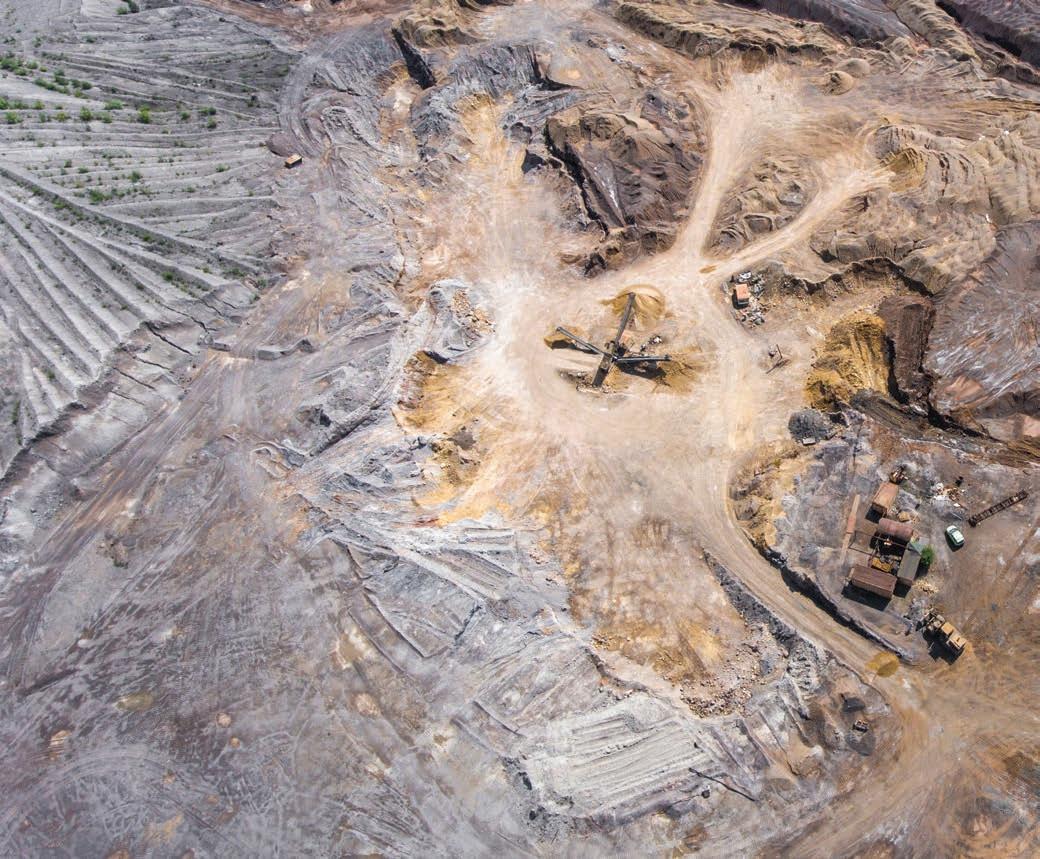
For companies like GRT, this reality highlights the need for greater protection for workers. Already, research has suggested their products deliver a maximum of 75 per cent cost saving compared to conventional methods, and are significantly more effective.

APRIL/MAY 2023 81 MINING
LEFT: GLOBAL ROAD TECHNOLOGY RECEIVED $100,000 IN ROUND NINE OF THE QUEENSLAND GOVERNMENT'S IGNITE IDEAS FUND FOR THEIR DUST CONTROL SOLUTION.
A DARING DEVICE
To combat dust pollution, GRT have proposed their SMART Dosing Unit, which enhances the effectiveness of dust suppression and water management systems on mine sites. The polymer-based dust suppression technique stops the generation of dust particles while also stabilising road surfaces. It is designed to work under extreme weather conditions without negatively impacting the environment.
It works as a water additive, increasing the efficiency of water to capture dust particles for a longer duration. This reduces water usage and allows for more effective dust suppression.
GRT CEO Troy Adams says the funding will allow the company to enhance its presence in the national market. He hopes to provide mining
sites with a simple solution to reducing dust pollution.
“Our SMART dosing technology is receiving great traction in the mining industry, with trials being run on some of the biggest mine sites in Australia as mines look at ways to reduce their carbon footprint and the amount of particulate pollution generated by their activities – both issues that our product can address.

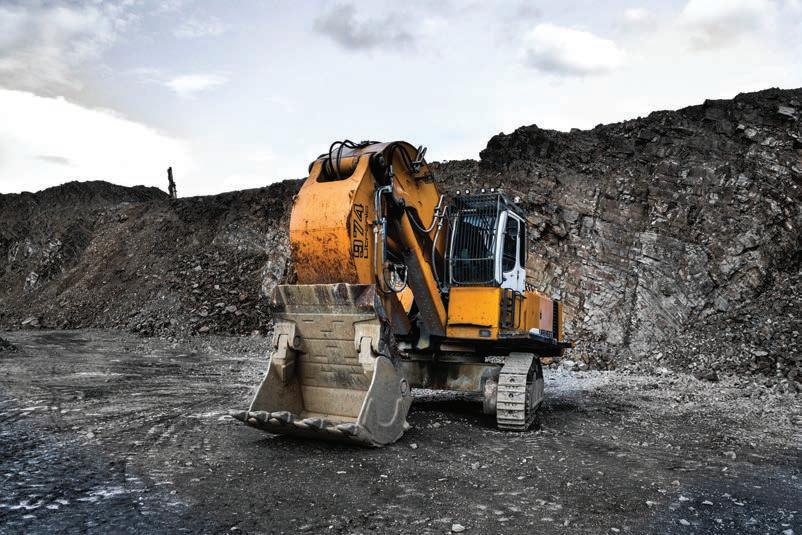
“Designed and assembled by GRT’s engineers, these Australianmanufactured SMART Dosing Units consist of a central control and satellite communication module utilising complex technology to provide the ability to remotely control and automate product use.
“As a company, we are grateful for the support of the Queensland government’s Advance Queensland Ignite Ideas initiative, as the funding will assist us in accelerating our growth, while at the same time assisting the mining industry as it protects workers and the environment.”
The funding announcement coincides with GRT’s continued expansion into an internationally recognised engineering technology company. In February, they revealed a partnership with TotalEnergies Marketing Australia, which will offer a collection of environmentally safe, sustainable and cutting-edge dust suppression products.
82 AusBiz. MINING
THIS PAGE: MINE SITES IN AUSTRALIA ARE NOW TRIALLING GRT'S SMART DOSING UNIT TO REDUCE DUST POLLUTION.
“As a company, we are grateful for the support of the Queensland government’s Advance Queensland Ignite Ideas initiative, as the funding will assist us in accelerating our growth, while at the same time assisting the mining industry as it protects workers and the environment.”
1 MONTH FREE Discover your Spanish side INTERESTED ? SC AN ME https://www.trulyaus.com/language-lessons/ Try out the course with Truly Aus, and enjoy your 1st month FREE (with no obligation to buy)! A DAILY LESSON – Delivered straight to your inbox or app A STORY – Funny stories with authentic cultural references MICROLEARNING –ADAPTIVE LEARNING – Personalised content that adapts to your level and interests
CRUNCH TIME FOR THE POTATO INDUSTRY
Australia’s nation-wide potato shortage looks to continue throughout 2023, leading to a lack of potato products on supermarket shelves.
words: Matilda Meikle

READ IT ONLINE 84 AusBiz. AGRICULTURE
Due to the ongoing effects of flooding and fluctuating weather conditions seen throughout 2022, potato farmers have been unable to keep up with demand for this popular produce.
The call for frozen potato products, and discussions with major brands, has led to sourcing problems for restaurants and supermarkets alike. So far, the cost of potatoes has increased by around 25 per cent, and we’re yet to see what will happen over the coming months.
So, what exactly is the issue? And how are farmers being affected?
THE POPULAR POTATO INDUSTRY
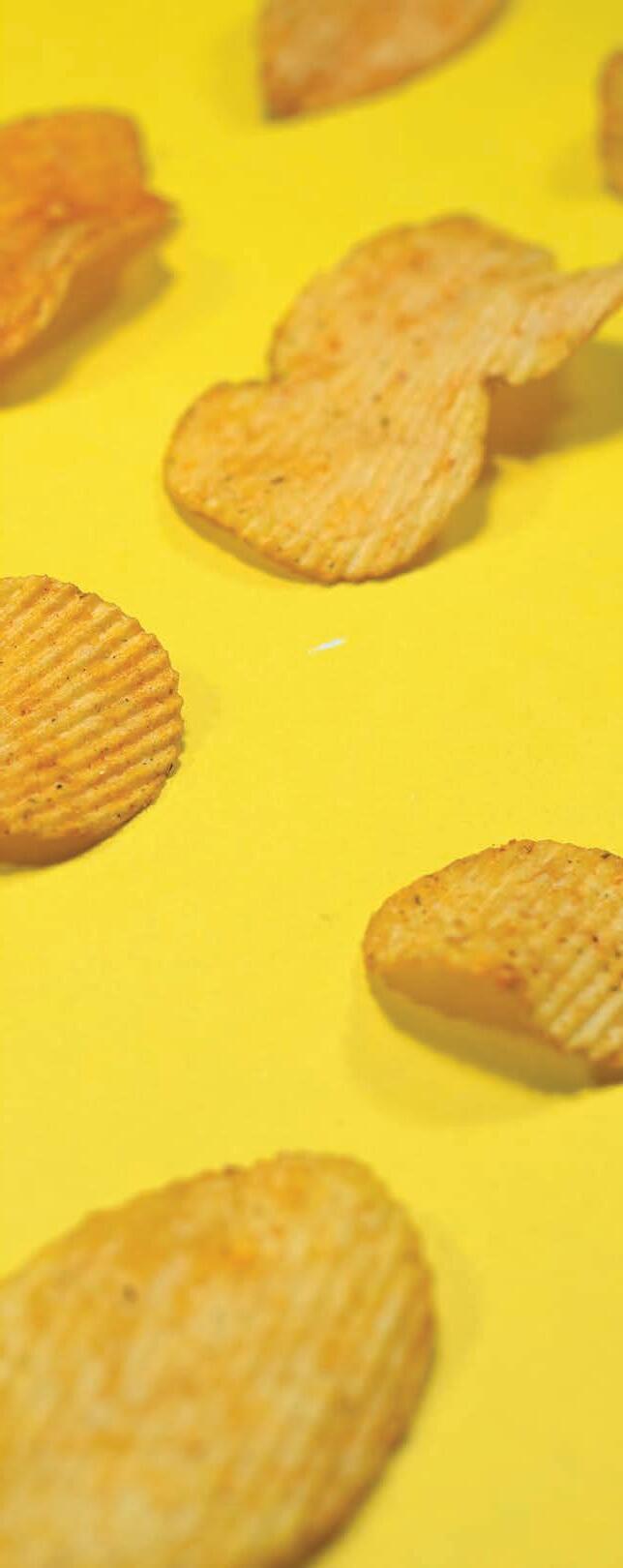
From chips, to crisps, to mash, Australia is a country in love with the humble potato. As such, the industry is now worth around $750 million. Potatoes represent the largest group of vegetables grown in Australia

APRIL/MAY 2023 85 AGRICULTURE
“From chips, to crisps, to mash, Australia is a country in love with the humble potato. As such, the industry is now worth around $750 million.”
by volume, coming in at over 1 million tonnes every year. This accounts for around 20 per cent of all horticulture production in Australia.
Potato crop is grown on around 28,000 hectares of land. However, this industry can be split into several sectors: seed potato production, ware potato production (used for the fresh market), and processed potato production (used for frozen produce, chips and crisps). Each sector has its own practices and crop management, but all are responsible for delivering delicious potatoes across the country.
The industry is divided into these subcategories due to the different types of potatoes required for each sector. As such, the shortage is mostly affecting spuds needed for processed production. Lovers of chips and frozen products may struggle to get their hands on their favourite snacks in the year to come.
This shortage is largely due to the floods of 2022. Potatoes are usually planted at the end of October, but intense weather conditions meant many farmers were prevented from planting stock until December. As such, potato harvests in regions like Ballarat were reduced by one-third
after potato plants were damaged –and it looks like things aren’t getting much better. Farmers say the ground has been too wet to place machines in paddocks to sow the potatoes, leading to ruined harvests.
To preserve the potato stock still available, major brands like Coles have introduced purchase limits on freezer potatoes, while cafes and restaurants are being forced to get creative with their menu offerings.


OTHER IMPORTANT FACTORS
While weather concerns are the major factor in Australia’s potato crisis, there are also other important contributing elements. For example, farmers claim they aren’t being paid enough for their produce, calling on big brands like McCain Foods for a 78 per cent price increase to remedy this.
Last season, McCain paid their growers an average of 33 cents per
kilo of spuds, yet it costs farmers around 51 cents to produce a kilo of potatoes. With harvest already down 20 per cent, and factors such as pest control and labour costs increasing expenses for farmers, the lack of pay is making potato production seem less and less viable.
Simplot Australia faced similar backlash last year when they refused to increase its pay rates after Tasmanian farmers asked for better wages. While farmers estimated it cost around $20,000 a hectare to produce their potatoes, Simplot was unwilling to compensate for these costs during negotiations.
Overall, it looks like the potato shortage will continue into 2023, with future impacts remaining to be seen. Australians should be prepared to see less and less of their favourite potato products on the shelves, while farmers continue to recover after a hard 2022 season.
THIS PAGE: LOVERS OF CHIPS AND CRISPS MAY STRUGGLE TO GET THEIR HANDS ON THEIR FAVOURITE PRODUCTS IN THE YEAR TO COME.
86 AusBiz. AGRICULTURE




CONTACT: E: publisher@trulyaus.com W: ausbizmedia.com P: 0425 325 202 @ausbizmedia@ausbizmedia TECHNOLOGY MINING AGRICULTURE FINANCE PROPERTY ENVIRONMENT BUSINESS CHARITY WE CREATE STORIES THAT MATTER TALK TO US ABOUT HOW WE CAN SHARE YOURS The home of real Australian business stories
FOR

THE LONG
RUN: CHARITIES SUPPORTING AUSSIE COMMUNITIES
88 AusBiz. CHARITY
READ IT ONLINE
These Aussie charities are all about supporting those in need by getting the community involved, whether it be through donating or volunteering. They believe that by working together, Australians can make a positive difference to the lives of people around them – for the long run.
ON MY FEET
On My Feet is a volunteer-run charity which helps those experiencing homelessness to find work and shelter. It was started in 2014 by Keegan Crage and has now expanded into a major organisation based in both Perth and Melbourne.


The charity aims to help people experiencing homelessness move from ‘shelter to self-sufficiency’ through its Footsteps Program. The six-month program provides education, exercise opportunities and employment skills training to participants through weekly meetings, providing people with the skills they need to get back on their feet –whether it be through improved mental health, financial stability or something else entirely.
To fund this successful program, the charity sells socks that are packaged and mailed by former Footsteps participants. This means that with every pair of socks you buy, you are providing someone with a job, and funding future participants on their journey to stability. Graduates from the program acquire all the skills they need to be job-ready, seek long-term housing and improve their mental health.
that leaders can come from all parts of society. Many schools have gone on to complete their own fundraising drives, with proceeds going straight to helping those in need.
Period poverty is an issue that effects women around the world, and TABOO is hoping to change that. They sell organic and sustainable sanitary products to Australian customers, and then donate 100 percent of the profits to their partner, One Girl, an organisation which runs programs in Sierra Leone and Uganda to keep girls in school and women employed. Both organisations want to educate women on how to deal with their period in a hygienic and culturally appropriate way.
TABOO also offers the opportunity
APRIL/MAY 2023 89
TABOO
CHARITY
This inspiring not-for-profit also encourages schools to participate in workshops where they break down stereotypes around homelessness and teach students how to engage with the community. The focus of these sessions is teaching young people how to be community leaders and helping them to acknowledge DONATE HERE DONATE HERE
Words: Matilda Meikle
“The focus of these sessions is teaching young people how to be community leaders and helping them to acknowledge that leaders can come from all parts of society.”
TOP TO BOTTOM: ON MY FEET FUNDS ITS PROGRAM BY SELLING SOCKS. IMAGE: ON MY FEET; TABOO AIMS TO END PERIOD POVERTY. IMAGE: TABOO.
to purchase period products for people suffering from period poverty in Australia. At-risk groups include Indigenous communities, school children, people experiencing homelessness, those fleeing domestic violence and more. By donating sanitary products, those at risk are able to stay healthy and engage in the community.
In 2019 and 2020 alone, TABOO donated 1,065 boxes of sanitary products to those in need. They also organised presentations at schools to break down the stigma surrounding periods and help Aussie youths understand the common struggle to access necessary sanitary products.
TABOO wants to bring an end to period poverty, and they are doing it one box at a time.

EDMUND RICE CAMPS
Edmund Rice Camps is an organisation all about supporting young people who have suffered from challenges and trauma. They want children to feel seen and heard by providing them with a safe and happy

environment where they can learn new skills and engage with others.
To achieve this, they offer week-long and weekend camps for children who may not be able to afford or access similar opportunities under normal circumstances. These camps are designed and run by youth leaders, who act as friends and mentors, guiding participants through teambuilding exercises and activities.

The main goal of Edmund Rice Camps is mentoring and support for young people. They hope that by giving them the opportunity to thrive in a protective environment, kids will be able to challenge themselves and grow as individuals. The camps are all about celebrating diversity and trying new things.
Each camp also provides food and accommodation. Community members are encouraged to nominate children in their area who are suffering or unable to access support. The team then ensures those most in need are given the chance to experience this camping opportunity. It’s exciting and engaging for young people, but it also teaches them important life skills so that they can go on to thrive.
90 AusBiz.
CHARITY
DONATE HERE
TOP TO BOTTOM, THEN RIGHT: EDMUND RICE CAMPS SUPPORT YOUNG PEOPLE WHO HAVE EXPERIENCED HARDSHIP; TABOO'S ORGANIC COTTON TAMPONS. IMAGE: TABOO.
beyond anxiety













LORD OF THE FRUIT FLIES

Every year, fruit flies destroy hundreds of millions of dollars' worth of fruit and vegetable in Australia. But after three successive years of La Niña, some parts of our country are facing the worst fruit fly infestation on record – and the potential for losses to escalate into the billions. We speak to three Australians on the frontline of the war against one of the world’s most destructive agricultural pests.
Words: Ian Lloyd Neubauer
92 AusBiz.
ENVIRONMENT
THIS PAGE: THE HUMBLE FRUIT FLY IS ONE OF THE WORLD'S MOST DESTRUCTIVE AGRICULTURAL PESTS.
THE OLD TIMER
“Fruit flies are nothing new here in South Australia. We’ve never been free of them. But I’ve been a farmer for 30 years and last year was the worst I’ve ever seen. The climate has been perfect for them and they can breed more than they usually do and in places we have never seen them before,” says Mark Doecke, an orange farmer and chairman of Citrus South Australia.
Mark reckons 80 per cent or more of the problem stems not from orchards like his but from fruit trees in residential areas. “In the summer, fruit flies will naturally go to people’s backyards where it’s cooler. And there’s nothing that they love more than stone fruit, so people can make a huge difference by maintaining their fruit trees. That means picking fruit off their trees as soon as they ripen and not leaving any rotten fruit on the ground. Or just getting rid of the trees altogether. In Waikerie, a town not far from where I live in the Riverina region, the government is running a program where they’ll take fruit trees out of your garden and replace them with gum trees – free of charge. It’s only been going since December but the uptake has been good. They’re already removed more than 100 trees.”
The Department of Primary Industries in South Australia is also trialling a more high-tech solution: Sterile Insect Technique, or SIT,
where male fruit flies that have been sterilised with an X-ray are released by light aircraft over fruit growing areas. Female fruit flies can’t detect they are sterilised, so they mate but nothing transpires. Fruit fly populations are thus reduced.

“It’s the biggest and best tool in our box,” Mark says. “Unlike pesticides, SIT is non-invasive, you can put them everywhere and people don’t get upset. They’ve been releasing 20 million per week but with this many fruit flies, it’s not enough. By spring they’re hopefully going to double it to 40 million per week.”
THE INVENTOR
“We’re always facing pests and diseases that are seasonally dependent, but fruit flies have always been one of those things we find very difficult to control,” says Brendon Hoyle, an organic strawberry farmer in the Glass House Mountains of Southeast Queensland.
“With soft skin fruit such as strawberries, they lay the eggs under the skin and the larvae eat through the inside. A lot of the time, it is quite difficult to notice there’s a problem by just looking at the fruit from the outside, which makes it really hard for us to rely on the quality of our strawberries. Two years ago the infestation was so bad we had to stop growing in the middle of the season.”
Brendon says fighting fruit flies is getting harder as a result of the nationwide trend towards less invasive farming techniques: “The agricultural industry as a whole is starting to clean up its act and use softer chemicals. And while that is a good thing and much better for our health, with that we are losing the ability to control fruit flies. As an organically certified farmer, I can’t use any chemicals at all. So we have to come up with new kinds of defences. We are looking at options all the time.”
ENVIRONMENT
APRIL/MAY 2023 93 READ IT ONLINE
“The agricultural industry as a whole is starting to clean up its act and use softer chemicals. And while that is a good thing and much better for our health, with that we are losing the ability to control fruit flies.”
Brendon is currently using a combination of defences that include sticky traps, sterilised fruit flies and, believe it or not, a giant vacuum cleaner he invented that won him the title of Australian Organic 2022 Farmer of the Year.
“In 2015, I was in the US where they also have big problems with fruit flies, and I saw a bug vacuum cleaner towed with a tractor over a crop,” he says. “I brought the idea back to my farm and designed a version of it for strawberries. When I realised it helped, I made a bigger version that covers three rows of strawberries at the same time and sits 10cm over the strawberry plants. It has big hydraulically driven fans on top that suck the bugs off the crop and push them through a screen, which effectively kills them.”
THE CHAIR
“I’ve spent a lifetime working in agriculture and exports and I can tell you as far as problems go, fruit flies are huge,” says John Webster, chairperson of the National Fruit Fly Council.

“Look at it this way: the horticulture industry employs 60,000 people in Australia and exports $3 billion worth of produce every year. Forty-three per cent of that produce is susceptible to fruit flies. So, if we were to let the problem get ahead of us, fruit flies could instead become a billion dollar problem.”
The reason it hasn’t so far, John says, is all the fantastic work being done by the scientific community and customs officers who keep new fruit fly species out of Australia and make sure our exports are also fruit fly-free: “We have a reciprocal obligation with the countries we export to, to make
sure we don’t send them problems with our products. We don’t just whack it into a container and send it off. There’s a whole bunch of sciencebased protocols and very detailed negotiations to make sure our fruit and vegetables are safe for importing countries.”
John also credits the hard work authorities do to prevent fruit flies from travelling between states, especially out of Queensland, where 90 per cent of horticulture is susceptible to fruit flies. But he also believes everyday Australians can play a more active role in fighting fruit flies.

“When you fly into Australia, it’s really clear how vigilant we all have to be. You get fumigated against fruit flies in the plane when it lands and there are massive fines for bringing in certain kinds of foods,” John says. “But say you’re flying on Rex from Queensland to Mildura and you’re carrying a hitchhiker in your lunchbox you don’t know about. You then rent a car, cross the border to South Australia and inadvertently cause an outbreak.
“That’s why you have to be very careful not to carry any fruit and vegetables from one airport to another,” he says. “Don’t bring it to eat, not even at the airport before you take off. Leave it at home. It will make a huge difference. Every bit of effort will make a difference to our biosecurity.”
94 AusBiz. ENVIRONMENT
“When you fly into Australia, it’s really clear how vigilant we all have to be. You get fumigated against fruit flies in the plane when it lands and there are massive fines for bringing in certain kinds of foods.”
LEFT TO RIGHT: THE QUEENSLAND FRUIT FLY LAYING EGGS IN A RIPE FRUIT; THE MEDITERRANEAN FRUIT FLY. IMAGE: PIA SCANLON, DPRID WA.

TRULYPACIFIC.COM @trulypacific Dive into the Pacific Islands with us… NEW ZEALAND | FIJI | HAWAII | FRENCH POLYNESIA VANUATU | PAPUA NEW GUINEA | SAMOA A WORLD OF SIMPLE PLEASURES AND WILD WONDERS AWAITS
MYLKING IT
With non-dairy alternatives on the rise, Norco Co-operative – one of Australia’s last 100 per cent farmer-owned dairy co-operatives – has launched its new mylk range.
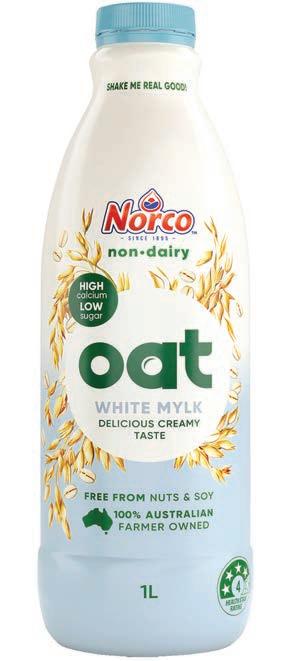 Words: Danielle McIltrot
Words: Danielle McIltrot
This new range features a P2 Pea Protein Mylk and Oat Mylk, allowing customers to buy both dairy and non-dairy products without needing to compromise on nutrition or taste.
Norco’s P2 Pea Protein Mylk is a plant-based milk alternative with the same protein, calcium and creaminess as full cream dairy milk. Designed to deliver the dairy benefits that other plant milks lack, it is free from gluten, soy, nuts and lactose, while also delivering a nutritional punch that is hard to beat.
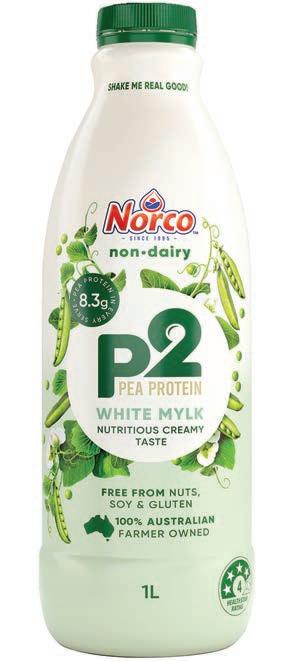
Nutritionist and food educator
Georgia Barnes gives Norco’s P2 Pea Protein Mylk five stars for its nutritional value, but says it is the

taste that will create a new benchmark in the rise of alternative milks.
“It’s got a creamy, sweet and subtle flavour which makes it incredibly versatile,” Georgia says.
Consumers might also enjoy Norco’s Oat Mylk which is just as creamy, delicious and milky-tasting as P2 Pea Protein, but instead uses oat grains. High in calcium, low in sugar and great mixed into your beverage of choice, this Oat Mylk offers a great dairy, nut and soy free option.
Norco’s General Manager of Commercial and Strategy, Ben Menzies says that while plant-based diets are growing in popularity and an increasing number of consumers shop
for both dairy and non-dairy items, many of the products in market sadly do not benefit Australian farmers.
Releasing this range of ‘mylk’ allows customers to continue to support local Australian farmers through Norco, while still buying the variety of milk products they are looking for.
“We’ve been making award-winning dairy for 128 years, so we know a thing or two about how award-winning milk should taste. Because no matter how it’s made – or what it’s made from – we want to give Aussie milk-lovers the milk they deserve, even when it doesn’t contain a drop of dairy,” Ben says.
Norco P2 Pea Protein and Oat Mylks are available in one litre bottles in the dairy fridge at select Woolworths across Queensland, New South Wales and Victoria with an RRP of $5.50.
APRIL/MAY 2023 96 LAST WORD
THIS PAGE: NORCO'S NEW NON-DAIRY MYLKS HAVE A CREAMY, SWEET FLAVOUR THAT TASTES GREAT IN SMOOTHIES.
FOR SALE
Stunning Country-MeetsCoastal Lifestyle Farm






40 ACRES | 4 BED | 2.5 BATH | 5 CAR
A once-in-a-lifetime opportunity to secure an incomeproducing, second-generation, move-in ready and user-friendly beef cattle estate.
Lifestyle properties of this calibre are rare to hit the market. Utterly private and peaceful, this lifestyle farm is located on a 40-acre property just 10 minutes from Moruya, one of the most desirable locations on the pristine South Coast.




Enjoy your special pocket of life on the South Coast with daily coastal walks, stunning views, fresh air, uncountable activities and unspoilt sandy beaches.
For more information, call Elle on 0437 298 835, or simply scan this QR code.

What is your final destination?
We can help you get there.
Pursuing dreams is not reserved for a select group of people – doing what you dream of is everyone’s right.
Every journey begins with a single step – wherever you are going, Saxo is here for you. Built on Scandinavian values, designed in Denmark – invested in Australia.
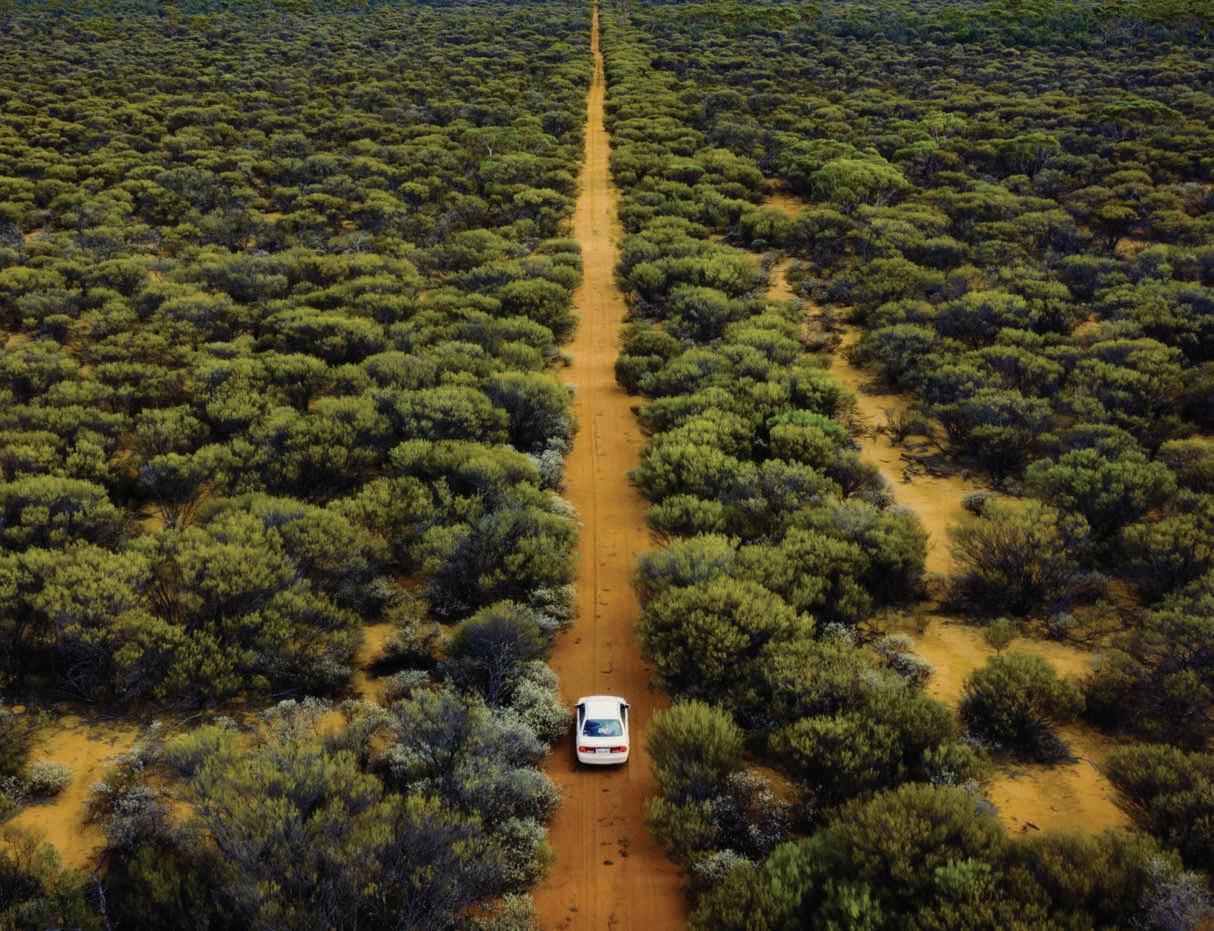
Trading can result in losses. Refer to our PDS and TMD via our website.











































































 Words: Danielle McIltrot
Words: Danielle McIltrot













